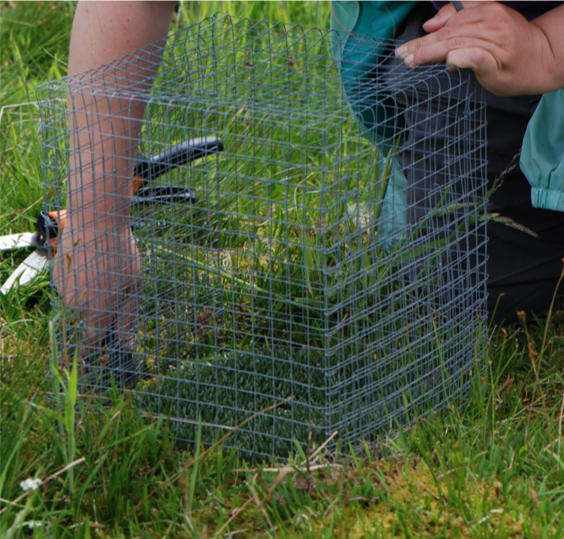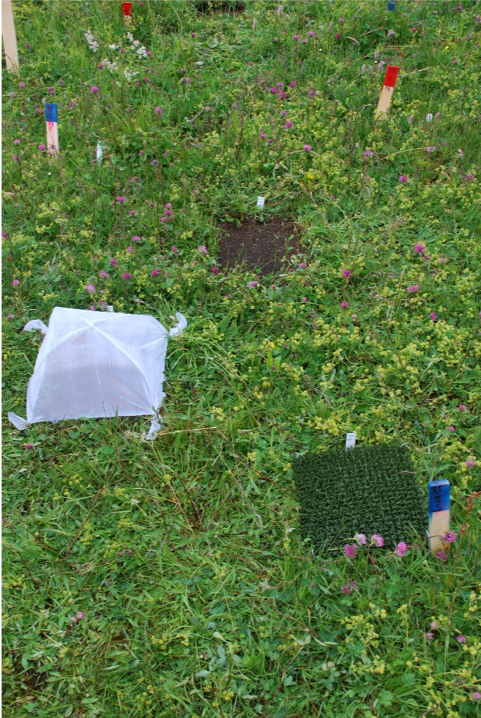Authors: Eycott AE1, Wilfahrt PA2
Reviewers: Vandvik V1,3, Tielbörger K4
Measurement unit: number of seeds m-2yr-1; Measurement scale: plot; Equipment costs: €; Running costs: €; Installation effort: low to medium; Maintenance effort: low to medium; Knowledge need: high (seed identification); Measurement mode: manual
Propagule rain (also called seed rain) is the supply of plant propagules to a local area over a given time. Propagule rain is a critical component of plant demography, community, and metacommunity dynamics. It is linked to changes in diversity (Vandvik & Goldberg, 2005), plant eco-evolutionary trade-offs (Mouquet et al., 2004), rates of migration and range expansion (Lockwood et al., 2009), and the colonisation and invasion of habitats (Levine & D’Antonio, 1999).
In this protocol we describe methods to quantify the propagule rain. A combination of input of local propagule production and dispersal from off-site locations is considered, because separating these is notoriously difficult. We distinguish between propagule rain and soil seed bank measurement as their methodology for detection is distinct (see protocol 4.6 The soil seed bank (buried seed pool)). Quantifying propagule rain may help explain shifts in population demographics or community composition by defining the potential of species to recruit new genetic individuals. This has clear application within the context of climate-change studies and may be relevant to other global-change studies but is rarely included in study designs. Propagule rain is a process likely to be affected by experimental infrastructure such as open-topped chambers or CO2 blowers as they affect wind speed (e.g. Fuhrer 1994) but we are unaware of any measurements of this effect.
4.7.1 What and how to measure?
There are two broad types of methodology for detecting propagule rain. First, there are seed trap-based options where seeds are intercepted at or just above ground level, removed, and identified. Trap-based methods can be used in vegetation types (e.g. forests) where destruction of the vegetation is not feasible or the source of the germinating propagules is not of interest. Sticky traps favour wind-dispersed seeds and expose seeds to predators and rainwash: they are occasionally used but not recommended (Kollman & Goetze, 1998; Chabrerie & Alard, 2005). Second, there are various ways to expose a seed-free substrate to the seed rain upon which you monitor emergence of seedlings in situ. This has the advantage of monitoring germination as it would occur under local conditions, but the disadvantage of causing greater disturbance to experimental plots. A “special case” method developed by Kadmon & Shmida (1990) and Siewert & Tielbörger (2010) can distinguish between propagule sources (local v. non-local propagule origins) and it can identify the actual consequences of seed rain for population dynamics, but is destructive and only suitable under particular circumstances (strictly annual species).
Seed traps

Excluding the non-recommended sticky traps (see above), there are two common designs for seed traps: mats and funnels. Whichever you use, the traps should be exposed throughout the whole season of seed dehiscence, with regular checking and cleaning.
The use of mats is more common in grassland and dwarf shrubland. Plastic doormats with ~1 cm tines are placed under the vegetation and the seeds which are caught in the tines are removed and recorded (Figure 4.7.1, Figure 4.7.2). Mat size varies from 25 x 25 cm to match vegetation recording plot size (Boixaderas, 2012) up to 50 x 80 cm to maximise trapped material (Birks & Bjune, 2010). To dislodge the seeds, the mats may be tapped with a hammer in the field (Molau & Mølgaard, 1996) or flushed with a shower attachment if the mats are removed to a laboratory. Particular care must be taken to dislodge seeds bearing hooks or awns.
In forests, seed traps made of funnels with mesh bags at the base are more common, and can be very efficient (Chabrerie & Alard, 2005). Litterfall traps can be used for this (see the ICP Forests litterfall protocol; Ukonmaanaho et al., 2016, although this may collect a very large sample for sorting, p. 8). Funnels have to be set below the vegetation layer of interest: for low-growing vegetation which potentially involves destructive digging in order to place the trap below ground but for trees it is effective. Funnels catch more seeds than horizontal rough surfaces such as mats (Johnson & West, 1988).
Funnels catch more seeds than horizontal rough surfaces such as mats (Johnson & West, 1988).
Unless a reference collection is already available, it is recommended to make one from local specimens of confirmed identity (Molau & Mølgaard, 1996). Lay the samples out to find the seeds: it is recommended to lay them out on dark paper or cloth (Molau & Mølgaard, 1996). A stereomicroscope is necessary to identify seeds. Many of the seeds may be dead or empty and should be omitted from the count; see protocol 4.2 Seed viability, germinability and dormancy for methods to test viability.
Monitoring seedling emergence on a seed-free substrate in situ
In the simplest form of this type of method, a deep layer of turf is extracted and inverted so seed-free soil becomes the top layer (e.g. 35 cm depth, Pakeman et al., 1998). When compared to a turf that has been disturbed but not inverted (i.e. extant vegetation removed), this allows for distinction between germination from the seed bank v. dispersed propagules while maintaining “field” conditions. The subsoil must be checked for deeply-buried seeds when using this approach. Less destructive is to use pots of sterile soil, but this exposes seeds to predators (Kollman & Goetze, 1998; Chabrerie & Alard, 2005). Such “field conditions” approaches measure germination under realistic conditions which could have a positive or negative effect depending on your research question. The substrate should be exposed before the season of seed dispersal until after the season of seed germination.
4.7.2 Special cases, emerging issues, and challenges

Identifying the source of newly germinating propagules allows for an enhanced understanding of local and metapopulation dynamics, species’ range expansions and contractions, and gene flow between populations (Kadmon & Shmida, 1990). Under particular circumstances the spatial source of propagules germinating in a particular patch can be further refined into those originating from local dispersal and longer distance dispersal. For very patchy populations, this may even be generalisable to dispersal from adults inside and outside the patch. One method for distinguishing these sources has been successfully applied in an annual plant system (Siewert & Tielbörger, 2010). In this method, extant vegetation was removed with a glyphosphate herbicide prior to seed production and germination rates compared with those in control plots (unherbicided) over the following year. Dispersal distances in the system can be measured simultaneously by removing plants within a certain radius and counting emerging seedlings along the radii. Additional census plots are necessary in the denuded areas to differentiate germinants that arrived from recent dispersal to those that were dormant in the pre-existing seed bank. This may be accomplished by covering additional subplots with netting that is permeable but fine enough to prevent dispersed seeds from reaching the subplot. By monitoring germination in the following year, this yields three subplot types with nested information on germinant sources: i) denuded and netted subplot germinants are recruited from the soil seed bank, ii) denuded subplot germinants are recruited from dispersal and from the soil seed bank, and iii) control subplot germinants are recruited locally from dispersal, and from the soil seed bank (Siewert & Tielbörger, 2010). While these techniques are powerful in detailing spatial and temporal dynamics of propagule rain, they are limited to situations where i) the destruction of extant vegetation is feasible within the study design and ii) the system is composed of strictly annual species, as perennial vegetation may resprout either from nearby or belowground, even following glyphosate application (Wilfahrt pers. obs.).
4.7.3 References
Theory, significance, and large datasets
Nathan & Muller-Landau (2000)
More on methods and existing protocols
Birks & Bjune (2010) or Molau & Mølgaard (1996) for doormats; Siewert & Tielbörger (2010) for the patch clearance based method.
All references
Birks, H. H., & Bjune, A. E. (2010). Can we detect a west Norwegian tree line from modern samples of plant remains and pollen? Results from the DOORMAT project. Vegetation History and Archaeobotany, 19(4), 325-340.
Boixaderas, M. R. (2012). Plant dispersal in a changing climate. A seed-rain study along climate gradients in Southern Norway. MSc thesis, University of Bergen, Bergen. Available at bora.uib.no/handle/1956/6575
Chabrerie, O., & Alard, D. (2005). Comparison of three seed trap types in a chalk grassland: toward a standardised protocol. Plant Ecology, 176(1), 101-112.
Fuhrer, J. (1994). Effects of ozone on managed pasture: I. Effects of open-top chambers on microclimate, ozone flux, and plant growth. Environmental Pollution, 86(3), 297-305.
Johnson, C. K., & West, N. E. (1988). Laboratory comparisons of five seed-trap designs for dry, windy environments. Canadian Journal of Botany, 66(2), 346-348.
Kadmon, R., & Shmida, A. (1990). Spatiotemporal demographic processes in plant populations: an approach and a case study. The American Naturalist, 135(3), 382-397.
Kollmann, J., & Goetze, D. (1998). Notes on seed traps in terrestrial plant communities. Flora, 193(1), 31-40.
Levine, J. M., & D’Antonio, C. M. (1999). Elton revisited: a review of evidence linking diversity and invasibility. Oikos, 87(1), 15-26.
Lockwood, J. L., Cassey, P., & Blackburn, T. M. (2009). The more you introduce the more you get: the role of colonization pressure and propagule pressure in invasion ecology. Diversity and Distributions, 15(5), 904-910.
Molau, U., & Mølgaard, P. (1996). ITEX Manual – International Tundra Experiment (2nd ed.) Copenhagen: Danish Polar Centre. http://ibis.geog.ubc.ca/itex/PDFs/ITEXmanual.pdf
Mouquet, N., Leadley, P., Mériguet, J., & Loreau, M. (2004). Immigration and local competition in herbaceous plant communities: a three‐year seed‐sowing experiment. Oikos, 104(1), 77-90.
Nathan, R., & Muller-Landau, H. C. (2000). Spatial patterns of seed dispersal, their determinants and consequences for recruitment. Trends in Ecology & Evolution, 15, 278-285.
Pakeman, R. J., Attwood, J. P., & Engelen, J. (1998). Sources of plants colonising experimentally disturbed patches in an acidic grassland, in eastern England. Journal of Ecology, 86(6), 1032-1041.
Siewert, W., & Tielbörger, K. (2010). Dispersal-dormancy relationships in annual plants: putting model predictions to the test. The American Naturalist, 176(4), 490-500.
Ukonmaanaho, L., Pitman, R., Bastrup-Birk, A., Breda, N., & Rautio, P. (2016). Part XIII: Sampling and Analysis of Litterfall. In: UNECE ICP Forests Programme Co-ordinating Centre (Ed.), Manual on Methods and Criteria for Harmonized Sampling, Assessment, Monitoring and Analysis of the Effects of Air Pollution on Forests. Eberswalde, Germany: Thünen Institute for Forests Ecosystems. [http://www.icp-forests.org/manual.htm].
Vandvik, V., & Goldberg, D. E. (2005). Distinguishing the roles of dispersal in diversity maintenance and in diversity limitation. Folia Geobotanica, 40(1), 45-52.
Authors: Eycott AE1,2, Wilfahrt P3
Reviewers: Vandvik V2,4, Tielbörger K5
Affiliations
1 Faculty of Biosciences and Aquaculture, Nord University, Steinkjer, Norway
2 Department of Biological Sciences, University of Bergen, Bergen, Norway
3 Department of Disturbance Ecology, BayCEER, University of Bayreuth, Bayreuth, Germany
4 Department of Biological Sciences and Bjerknes Centre for Climate Research, University of Bergen, Bergen, Norway
5 Institute of Evolution and Ecology, Plant Ecology Group, University of Tübingen, Tübingen, Germany